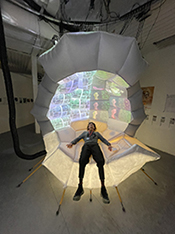2021 Venice Biennale | Geoscope 2: Worlds
POSTED ON: June 23, 2021

As part of an ongoing series of posts highlighting faculty and alumni projects featured in and associated with the Venice Biennale’s current 17th International Architecture Exhibition, the School of Architecture is pleased to share Geoscope 2: Worlds, a project by Jesse Reiser (AR’81) and Nanako Umemoto (AR’83) of RUR Architecture.
 Geoscope 2: Worlds is a split-sphere, multimedia installation showcasing over a dozen (and counting) contemporary voices inside and outside architecture, from Pritzker Prize-winning architect Kazuyo Sejima to radical ecologist and philosopher Timothy Morton. Visitors to the installation find themselves enveloped in a pneumatic, panoramic environment where projections on 42 individual facets generate a complex, kaleidoscopic ecosystem—a tableaux of world-thinking on the edge. Inspired by Daniel López-Pérez’s provocative and luminous book R. Buckminster Fuller: Pattern Thinking (Lars Müller Publishers, 2020), Reiser, Umemoto, and their team were challenged with displaying the breadth and quality of its content for an exhibition at Princeton University in February 2020. The result was the first iteration of Geoscope 2, a continuation of Fuller’s original geoscopes reimagined through contemporary means. The project’s second iteration is now on view at the 2021 Venice Biennale.
Geoscope 2: Worlds is a split-sphere, multimedia installation showcasing over a dozen (and counting) contemporary voices inside and outside architecture, from Pritzker Prize-winning architect Kazuyo Sejima to radical ecologist and philosopher Timothy Morton. Visitors to the installation find themselves enveloped in a pneumatic, panoramic environment where projections on 42 individual facets generate a complex, kaleidoscopic ecosystem—a tableaux of world-thinking on the edge. Inspired by Daniel López-Pérez’s provocative and luminous book R. Buckminster Fuller: Pattern Thinking (Lars Müller Publishers, 2020), Reiser, Umemoto, and their team were challenged with displaying the breadth and quality of its content for an exhibition at Princeton University in February 2020. The result was the first iteration of Geoscope 2, a continuation of Fuller’s original geoscopes reimagined through contemporary means. The project’s second iteration is now on view at the 2021 Venice Biennale.
The first geoscopes, constructed by students of R. Buckminster Fuller (1895-1983) 60 years ago, were conceived as embodiments of the world looking at itself, and a means of comprehensively understanding one’s relationship to the world. In response to the Biennale’s question “How will we live together?” Geoscope 2 flouts the idea of a single world body in favor of “many worlds”—chaos generated by multiple bodies interacting with each other—by literally splitting the sphere in half and opening it up to multiple contributors and perspectives.

As López Pérez and Reiser note:
Fuller’s geoscopes, while conceptually ambitious, were technologically limited by their times: literally analog vinyl spheres covered in decals in the shapes of the continents. The way we see it, new technologies and advances in how we view the world have allowed us to simultaneously reimagine and challenge Fuller’s original project. We believe that disunity, disjunction, and dissensus—‘worlds’—are to be celebrated as evidence of true diversity in how we think, act, and interact with one another. This is our critical take on how will we live together: spirited agon as opposed to polite relativism.
Photos and video by Princeton University’s School of Architecture.
Team
Mission Control: Daniel López-Pérez & Jesse Reiser
Geoscope 2 Design: RUR Architecture, Reiser+Umemoto
RUR Architecture Team: Julian Harake, Katherine Leung
Inflatable Design: Pablo Kobayashi / Unidad de Protocolos
Inflatable Fabrication Team: Lucía Aumann, Ernesto Falabella, Emilio Robles, Pablo Kobayashi / Unidad de Protocolos
Experience Design: Jan Pistor - Bureau 314 / for iart with support from Denim Szram
Exhibition Manager: Kira McDonald / Princeton University School of Architecture
Partnerships & Communications: Lukas Fitze / iart
Trailer Video: Onome Ekeh / Futurezoo




